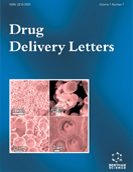Abstract
Multilayer tablet of tramadol hydrochloride was developed for the treatment of osteoarthritis. Multilayer tablet was comprised of immediate release layer, followed by drug-free retardant layers on either side of middle matrix layer. The sustained release effect was achieved by exploring the polysaccharide of tamarind kernel seed of Tamarindus indica. An extracted polysaccharide showed high swelling index and viscosity. Three-layer tablet system was optimized based on central composite design of two factors each at three levels, considering the amount of drug-free retardant layers, on either side (100 mg) of middle matrix drug polysaccharide layer (210 mg). Multilayer tablet was evaluated for hardness, thickness and drug content. Drug release is characterized by an initial rapid release (54% in acidic media), followed by a slow and again a second phase of relatively rapid release for 10 h. Presence of rat cecal content (2% and 4% w/v) in dissolution medium released the drug at a faster rate. Thus, inexpensive and abundantly available tamarind seed polysaccharide can be a good choice of polymer for dual release of multilayer tablet for arthritis patients.
Keywords: Immediate release, matrix tablet, multilayer tablet, tamarind seed xyloglucan polysaccharide, three-layer tablet, tramadol hydrochloride.
Graphical Abstract
Drug Delivery Letters
Title:Tamarind Seed Xyloglucan-based Multilayer Matrix Tablet of Tramadol Hydrochloride for Dual-Release
Volume: 5 Issue: 1
Author(s): Ashlesha P. Pandit, Kavita Kumari, Pooja Waychal and Kishanchandra Khandelwal
Affiliation:
Keywords: Immediate release, matrix tablet, multilayer tablet, tamarind seed xyloglucan polysaccharide, three-layer tablet, tramadol hydrochloride.
Abstract: Multilayer tablet of tramadol hydrochloride was developed for the treatment of osteoarthritis. Multilayer tablet was comprised of immediate release layer, followed by drug-free retardant layers on either side of middle matrix layer. The sustained release effect was achieved by exploring the polysaccharide of tamarind kernel seed of Tamarindus indica. An extracted polysaccharide showed high swelling index and viscosity. Three-layer tablet system was optimized based on central composite design of two factors each at three levels, considering the amount of drug-free retardant layers, on either side (100 mg) of middle matrix drug polysaccharide layer (210 mg). Multilayer tablet was evaluated for hardness, thickness and drug content. Drug release is characterized by an initial rapid release (54% in acidic media), followed by a slow and again a second phase of relatively rapid release for 10 h. Presence of rat cecal content (2% and 4% w/v) in dissolution medium released the drug at a faster rate. Thus, inexpensive and abundantly available tamarind seed polysaccharide can be a good choice of polymer for dual release of multilayer tablet for arthritis patients.
Export Options
About this article
Cite this article as:
Pandit P. Ashlesha, Kumari Kavita, Waychal Pooja and Khandelwal Kishanchandra, Tamarind Seed Xyloglucan-based Multilayer Matrix Tablet of Tramadol Hydrochloride for Dual-Release, Drug Delivery Letters 2015; 5 (1) . https://dx.doi.org/10.2174/2210303105666150428234445
| DOI https://dx.doi.org/10.2174/2210303105666150428234445 |
Print ISSN 2210-3031 |
| Publisher Name Bentham Science Publisher |
Online ISSN 2210-304X |
 27
27 1
1
- Author Guidelines
- Bentham Author Support Services (BASS)
- Graphical Abstracts
- Fabricating and Stating False Information
- Research Misconduct
- Post Publication Discussions and Corrections
- Publishing Ethics and Rectitude
- Increase Visibility of Your Article
- Archiving Policies
- Peer Review Workflow
- Order Your Article Before Print
- Promote Your Article
- Manuscript Transfer Facility
- Editorial Policies
- Allegations from Whistleblowers
Related Articles
-
Hypericin - The Facts About a Controversial Agent
Current Pharmaceutical Design Interrelationships Between Cyclooxygenases and Aromatase: Unraveling the Relevance of Cyclooxygenase Inhibitors in Breast Cancer
Anti-Cancer Agents in Medicinal Chemistry Alternatives to Conventional Vaccines - Mediators of Innate Immunity
Current Drug Targets The Role of Microbiota and Intestinal Permeability in the Pathophysiology of Autoimmune and Neuroimmune Processes with an Emphasis on Inflammatory Bowel Disease Type 1 Diabetes and Chronic Fatigue Syndrome
Current Pharmaceutical Design Advancement in Microsphere Preparation Using Natural Polymers and Recent Patents
Recent Patents on Drug Delivery & Formulation Food-Derived Peptides and Intestinal Functions
Current Pharmaceutical Design Kruppel-Like Factors 4 and 5: Unity in Diversity
Current Genomics P-gp Inhibition-Based Strategies for Modulating Pharmacokinetics of Anticancer Drugs: An Update
Current Drug Metabolism Methionine-Derived Metabolites in Apoptosis: Therapeutic Opportunities for Inhibitors of their Metabolism in Chemoresistant Cancer Cells
Current Medicinal Chemistry Midkine: A Promising Molecule for Drug Development to Treat Diseases of the Central Nervous System
Current Pharmaceutical Design Cancer Metastasis: Characterization and Identification of the Behavior of Metastatic Tumor Cells and the Cell Adhesion Molecules, including Carbohydrates
Current Drug Targets - Cardiovascular & Hematological Disorders Edible Transgenic Plant Vaccines for Different Diseases
Current Pharmaceutical Biotechnology Tetraplex Binding Molecules as Anti-Cancer Agents
Recent Patents on Anti-Cancer Drug Discovery Natural Resins and Bioactive Natural Products thereof as Potential Anitimicrobial Agents
Current Pharmaceutical Design Role of Secretory Phospholipase A2 in CNS Inflammation: Implications in Traumatic Spinal Cord Injury
CNS & Neurological Disorders - Drug Targets Chitosan Applications on Pharmaceutical Sciences: A Review
Drug Delivery Letters Chemical Constituents and Biological Significance of the Genus Ilex (Aquifoliaceae)
The Natural Products Journal Targeting Aldose Reductase for the Treatment of Cancer
Current Cancer Drug Targets Human Kallikreins: Common Structural Features, Sequence Analysis and Evolution
Current Genomics Molecular and Genetic Mechanisms of Osteoporosis: Implication for Treatment
Current Molecular Medicine


























